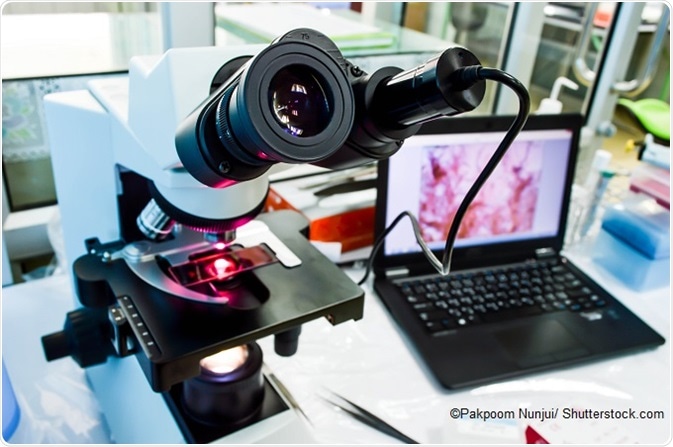Shelley Farrar, MSc, BSc
Digital pathology is the management of data formed from digital images of glass slides. There are four steps involved in the process of digital imaging:
- The acquisition of the image.
- Image storage and management.
- Image manipulation and editing.
- Image viewing, transmission and sharing.
The market for digital pathology technology is growing. Previously, slides were reviewed by trained pathologists and a photograph could be used to document their findings. Whilst well trained pathologists have provided slide reviews with accuracy, this method is still subjective and labor intensive. Digital pathology allows for easy data transference of more detailed images; however, there are still challenges to be overcome before digital pathology is implemented universally.

Advantages of digital pathology
In terms of diagnostics, digital pathology presents the potential for increased efficiency with a reduced turnaround time for reporting clinical cases. There is also the potential for increased output quality by reducing error rates. Telepathology is the use of telecommunication to transfer pathology data images between laboratories and other locations relating to research, diagnostic and educational purposes. In terms of laboratory workflows, telepathology provides the practical advantage of not requiring the physical shipping and storing of glass slides between locations. Image analysis efficiency and quality can also be improved by reducing manual errors through an automated system. For educational applications, students can learn from a wider range of case studies as digital pathology provides the ability to scan a single tissue sample that can be used repeatedly in classes.
Philips Digital Pathology, people and careers
Challenges of digital pathology
The implementation of digital pathology is not without challenges. None of the four steps required for the process of digital imaging have been standardised which is needed for routine clinical work. A test of the process found that dissimilar images were produced when six pathologists were asked to image the same region of a glass slide with microscopes that were attached with identical digital cameras. For digital pathology to be integrated into a clinical setting, rapid and stable scanning must be achieved. An international standard for digital archiving is also required. This includes re-working laboratory protocols and developing new scanning rules to attempt standardisation of digital imaging procedures.
Real-time reporting demands a fast transfer of data. Strong connections between the internet, laboratory information systems and electronic medical records are necessary for clinical implementation. Furthermore, the high resolution images require new systems of storage due to large file sizes. Digital pathology necessitates the incorporation of technology with excellent performance specifications, meaning current computers used for the digital pathology diagnosing station will need to be upgraded with better graphics cards and high resolution screens.
The collection and storage of medical data has also created issues in terms of data security. For hospitals and research organisations, where high standards of data security are required, there are further ramifications of implementing digital pathology technologies. Such organisations require the consideration of how long the data should be kept for and how the data can be stored in secure yet readable formats.
Difficulties implementing digital pathology in low-resource countries
The difficulties of implementing digital pathology technologies are greater in low-resource countries. In remote areas where there is a lack of trained pathologists, real-time digital pathology and telepathology can massively increase the efficiency of image analysis in these locations, but the requirement for a high bandwidth constrains the use of this technology in low-resource countries. Where only dial-up connections are available, frequent timeouts and low quality images mean that the use of digital slides are impossible on large networks - the use of digital slides within local networks has been found to be more promising. Moreover, there are barriers in the form of high equipment cost and the limited student access to laboratory workstations for educational applications. Whilst there are clear advantages to implementing digital pathology technologies, both in high and low resource countries, many challenges still need to be overcome; the growing market for digital pathology does indicate that a universal implementation may be achieved in the future.
Sources:
- Pantanowitz, L. 2010. ‘Digital images and the future of digital pathology’, Journal of Pathology Infomatics, 1: 15. https://www.ncbi.nlm.nih.gov/pmc/articles/PMC2941968/
- Higgins, C. 2015. ‘Applications and challenges of digital pathology and whole slide imaging’, Biotechnic and Histochemistry, 90, pp. 341-7. https://www.ncbi.nlm.nih.gov/pubmed/25978139
- Madabhushi, A. 2016. ‘Image analysis and machine learning in digital pathology: Challenges and opportunities.’, Medical Image Analysis, 33, pp. 170-175. www.medicalimageanalysisjournal.com/.../fulltext
- Allen, T.C. 2014. ‘Digital pathology and federalism’, Archives of Pathology and Laboratory in Medicine, 138, pp. 162-165. www.archivesofpathology.org/.../arpa.2013-0258-ED?code=coap-site
- Fontello, P. et al. ‘Digital pathology- implementation challenges in low-resource countries’, Analytical Cellular Pathology, 35, pp. 31-36. https://www.ncbi.nlm.nih.gov/pubmed/22233702
Further Reading